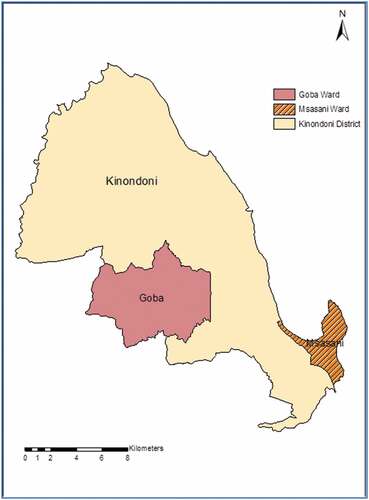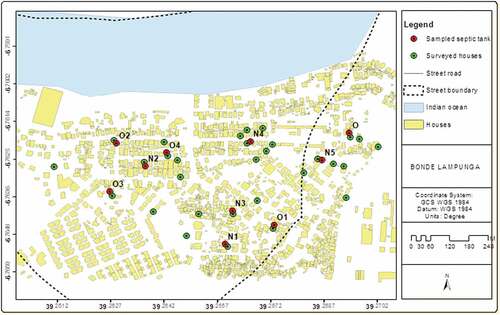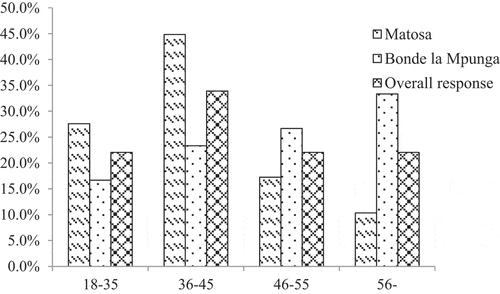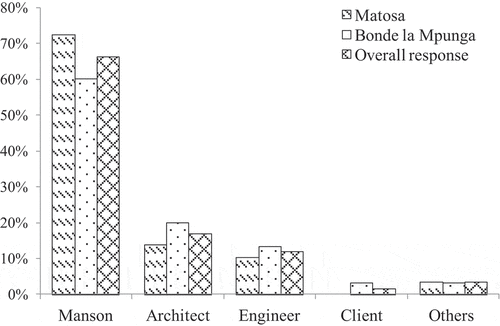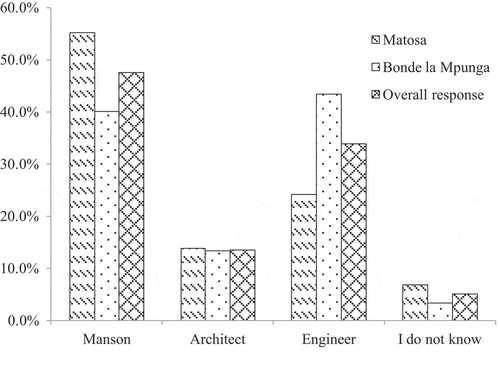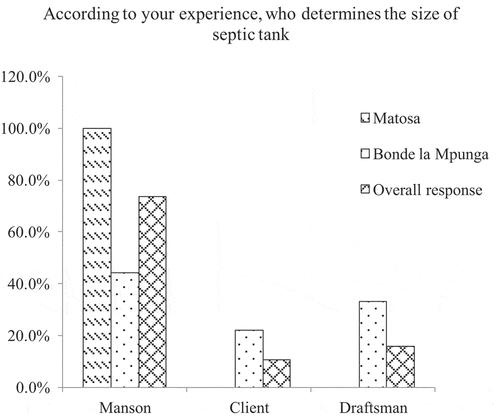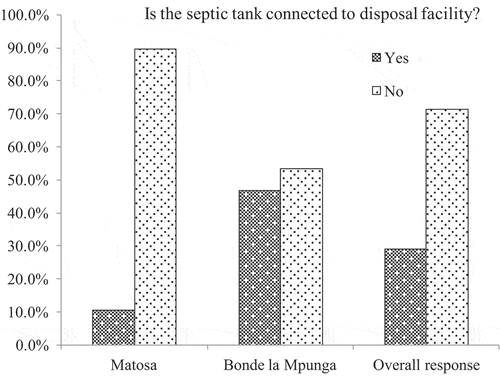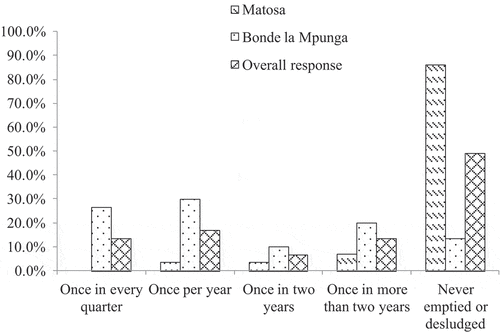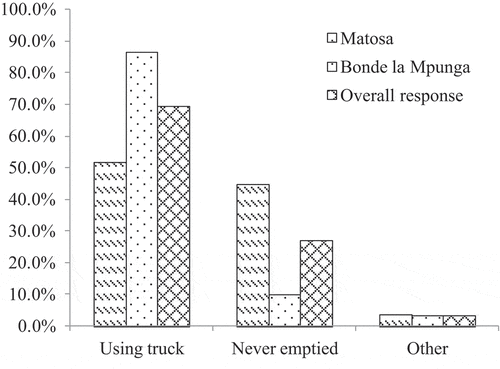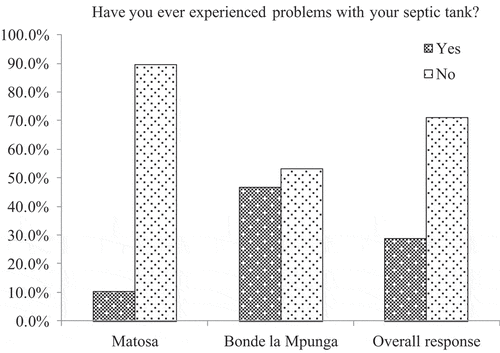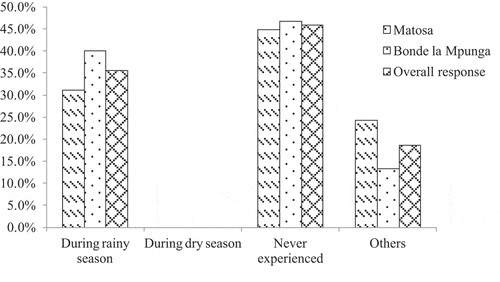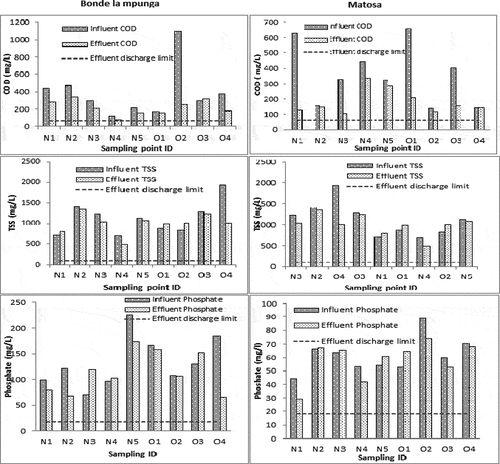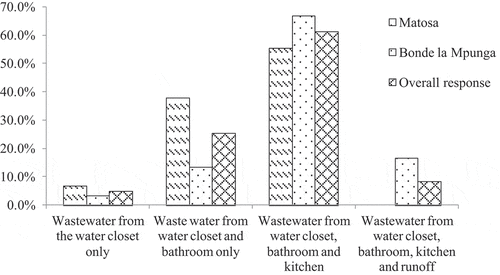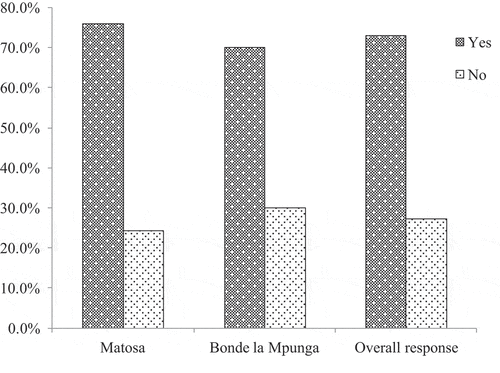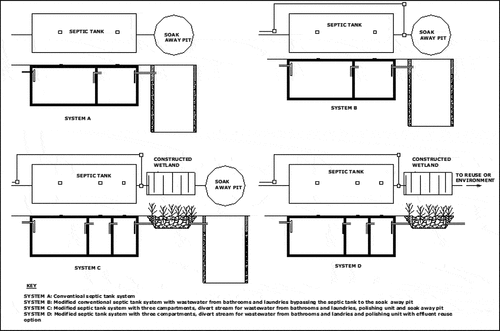Abstract
Onsite sanitation is widely adopted in developing countries. Septic tanks being one of the onsite treatment systems is still adopted and scaled up especially in urban settlements. But, experience shows that septic tanks are designed without due considerations of the site and environmental conditions as a result public health risks are imposed and higher operating costs are incurred. A study was conducted in two selected informal settlements in Dar es Salaam Tanzania to understand the practice, status and implication for the existing septic tanks. Results indicate that most of the systems are improperly designed and installed as a result they are equipped with low performance efficiency and a number of operational challenges. The main reported operational challenge is frequent desuldging that has impacts on both the public health and economy. In addition, level of awareness and low priority on sanitation were identified to be among the factors affecting sanitation. In this article, options under which the situation would be improved are considered and disscussed. Apart from proper designs, modifications of the septic tanks with consideration of the environmental conditions is considered to achieve better results than the conventional septic tank systems. Capacity building of local masons in the design and installation of septic tank systems; awareness sensitization to the public; and review of policy and guidelines to incoporate tailored designs are among the recommendations.
PUBLIC INTEREST STATEMENT
Septic tanks are widely used in urban and peri-urban areas of many developing countries as one of the improved onsite sanitation systems for management of human excreta. However, most of the septic tank systems are not properly designed and operated, and their construction is not informed of the environmental and site-specific conditions. The existing practices have led to challenges in operation and maintenance that has ultimately led to subsurface environmental pollution. In order to avoid these problems, research calls for tailored designs and proper practice that would promote pollution and operating cost reduction as well as provision of safe and convenient onsite sanitation. To realize this, policy strategies flexible to incoporate site-specific designs and construction need to be availed and reinforced.
1. Introduction
Pollution from onsite sanitation systems calls for proper interventions to ensure environmental sustainability (Govender et al., Citation2011; Palamuleni, Citation2002). Unfortunately, in most developing countries, the ongoing efforts to improve water supply have not been in pace with sanitation improvement, hence sanitation sector still lags behind. Onsite sanitation which is the most predominant often employs unimproved sanitation facilities with unsafe management practices resulting to negative impact to the public health and the environment. Onsite as opposed to offsite centralized systems collects and handles wastewater and sludge onsite thus; if not properly managed, can impart localized negative impacts.
Literature indicates that, in African countries, onsite sanitation accounts for more than 60% of sanitation coverage (Nansubuga et al., Citation2016) whereby the most prevalent sanitary facilities are pit latrines, septic tanks and ventilated improved latrines. Among the three types, septic tanks are the most common in non-sewered urban and peri-urban sprawls as they are considered the next advanced and affordable choice in the sanitation ladder than pit latrines. In Tanzania, pilatrines are considered as the cheapest option and are widely used. Literature indicates that pitlatrines are still most predominant even in urban settings (Jenkins et al., Citation2015; Sakijege et al., Citation2012). However, new housing schemes are now adopting pour flush toilets connected to septic tanks in place of pitlatrines. The installed septic tanks are used as containment, treatment and disposal facilities. However, most of these systems are associated with environmental pollution and operational problems. The extent, impact and tailored remedial measures are not well established in literature.
Strategies to improve sanitation are affected by lack of clear standards and guidelines, poor planning and uncontrolled new developments leading to informal installations with no conformity to the master plans. For example in Dar es Salaam informal settlement are estimated to be home of more than 70% of city population (Sakijege et al., Citation2012). The adoption of sanitation facilities is not controlled as it is for the housing. Therefore the installations are not informed of the technical and environmental aspects. On the other hand, sanitation financing is still low and as it is for many developing countries, Sanitation sector is still lagging behind because of low priority and lack of investment (Isunju et al., Citation2011; Nath, Citation2003). Also the lessons learnt from the existing practice, have not guided the plans for improving sanitation improvement. Therefore, there is a gap that need to be filled with informative research.
A study was conducted in selected two informal settlements to find out the challenges in terms of design, construction and operation and generate information for tailor-made solutions that may prevent pollution and reduce operating costs. This would ultimately assist in the development of tailor-made design of septic tanks adaptable to the local situation for improved onsite wastewater management systems and realized economic benefit.
2. Methodology
2.1. Description of the case study area
The study was conducted in Dar es Salaam city at Bonde la Mpunga (Msasani ward) and Matosa (Goba ward) of Kinondoni and Ubungo Municipalities respectively (Map 1). The two case studies share similar climatic conditions (temperature of 25.9°C and annual average rainfall of 1089 mm) with variable environmental conditions. Bonde la Mpunga is a reclaimed land that was a swampy in the past. The area is located relatively near the city centre and is characterized with high population density; poor accessibility; poor drainage and high water table. Matosa which is a relatively newly developed (with undeveloped plots) is about 20 km from the city centre is relatively less congested, but is characterized with irregular housing pattern. The choice of the case study areas was informed by the age of the septic tank systems, the environmental conditions and settlement characteristics.
Map 1: Spatial location of the study areas within the Kinondoni Municipality, Dar es Salaam
2.2. Data-collection methods
The study employed both quantitative and qualitative methods for collection of primary data. Quantitative data was collected through surveys (conducted to selected households and the local mason) and laboratory analysis of wastewater samples from the septic tanks. The survey was conducted to obtain data on the design of the septic tanks, the construction details, manner of operation and maintenance as well as the levels of awareness on issues related to wastewater management. Households who are the owners and users of the septic tanks and the masonry who are involved in the construction were the respondents to the designed questionnaires. Qualitatively, interviews were conducted with the community leaders and the local mason to get more insights of practices and challenges with management of septic tanks and sanitation in general.To understand the performance of the septic tanks for pollutant removal, wastewater samples were collected and analyzed at Ardhi University laboratory. Influent and effluent samples from the septic tanks were taken and analyzed for the parameters of interest using standard methods for examination of water and wastewater as described in APHA, 1989. Parameters analyzed include the COD, phosphate, nitrates and physical parameters including pH, electric conductivity (EC), total dissolved solids (TDS), alkalinity and temperature. The choice of parameters was based on their importance in portraying the physical and chemical characteristics of wastewater.
2.3. Sampling
The sample size was 59 (30 from Bonde la Mpunga and 29 from Matosa) and 19 (10 from Bonde la Mpunga and 9 from Matosa) for households and local masons survey respectively. Purposive sampling was employed to ensure that households with septic tanks and local masons who are involved in construction works in the respective areas are selected. For wastewater samples, 20 (10 from each area) septic tanks were selected for sampling. Again the sampling was purposive to ensure that septic tanks with soakaway pit are included but at the same time ensuring uniform spatial distribution of the tanks (Map 2 and 3). In addition, septic tanks with functional manholes that are easily opened and closed were selected. Old and new septic tanks were included but only those with owner's willingness to offer accessibility. The age of the septic tank was of interest to allow comparison in performance between old and new septic tank systems. For the sake of analysis, septic tanks constructed from 2014 to 2017 were grouped together as new systems in Bonde la Mpunga and septic tanks constructed in 2013 and back were grouped as old systems in Goba. On the other hand, septic tanks constructed from 2007 to 2017 were regarded as new while those constructed from 2006 and back as old systems in Bonde la Mpunga. The old and new systems were coded N and O as seen in Map 2 and 3. After screening process, the selected households were coded and numbers were used to label the sampling bottles. Samples of wastewater were collected in triplicates from each of the selected septic tanks at an interval of two weeks.
Map 2: Spatial distribution of sampled households in Bonde la Punga case study
Map 3: Spatial distribution of sampled households in Matosa case study
3. Results
3.1. Characteristics of the respondents
The majority of the respondents were male (70% of the respondents) with age distribution as show in Figure . In addition, all the respondents were adults within the age range of 18–75 years. The age distribution and level of education of the local mason who were also respondents is as shown in Table . Data show that more than one third (36%) of the respondents have primary education and technical training while few (10%) of the respondents) have never attended school.
Table 1. Age and level of education of the local masons
3.2. Personnel employed in design and construction of septic tank
With regard to employment of relevant technical personnel in design and construction of septic tanks, results revealed that many (66%) of the surveyed households in Matosa and Bonde la Mpunga employed local mason, few (12%) of the households mentioned to have consulted engineers and the rest (22%) either consulted an architect or used own design (Figure ). Furthermore, it was found that there is low public awareness on who is the relevant professional for the design the septic tanks as the majority (45%) of all the respondents pointed out that the mason is the most relevant. Further results indicated that, only few (34%) of the respondents were aware that the sanitary engineers are responsible for the septic tank design; very few 13% of the respondents) mentioned the Architect to be the designer and the rest (5% of the respondents) did not know the responsible professional (Figure ).
In view of the responses above, local masons are considered by many to be responsible in design and installation of septic tanks. When they were contacted, most of the respondents (74%) confirmed that they are involved in design and construction of septic tanks (Figure ).
3.3. Status, operation and maintenance of septic tanks
Means of disposal of effluent from septic tank and the operation and maintenance of septic tanks are important for sustained service delivery and improved public health. In this study it was revealed that most of the respondents (71%) indicated that their septic tanks do not have the disposal facilities and in this case they serve for both treatment and containment (Figure ).
Normally septic tanks need to be desludged within a time interval known as desludging period which ranges from 1–4 years (AU-EPA, Citation2016). The findings (Figure and ) revealed that a significant proportion (30% of the respondents) of people experience a higher desludging frequency (either once every quarter or once every year). The desluding practice in both areas is mainly using the truck emptier (70% of the respondents). While others ((27% of the respondents) have never emptied. In the interviews with the local masons it was learnt that some households opt to empty manually and unsafely dispose wastewater and sludge to the environment. This practice does compromise the public health especially of those involved in emptying activities.
3.4. Operational problems associated with the septic tanks
Results indicate that operational problems are mainly experienced in the rainy season (Figures and ). The main reported challenges include leakage and frequent overflows of raw sewage leading to frequent emptying and desludging. Interviews with the community leaders confirmed the occurrence of such challenges and it further reported that haphazard means for emptying and desludginng are done as a resort.
3.5. Laboratory results
Laboratory results indicated COD removal efficiencies within a range of 10–70% and that none of the sampled septic tanks were able to treat the wastewater meeting the discharge limit of 60 mg/L as COD. Results have a highest COD removal efficiency record for the septic tank labelled O2 available at Bonde la Mpunga and the lowest COD removal efficiency of the septic tank O3 in Bonde la Mpunga (Figure ). Furthermore, results indicate the there was insignificant removal of TSS except for O4 in Bonde la Mpunga and O4 in Matosa.
Nutrient removal in wastewater treatment plants is meant to safeguard the receiving environment against nutrient overloading that would lead to adverse environmental problems such as eutrophication (Mechtensimer & Toor, Citation2017). The laboratory analysis for phosphate (one of the nutrients) revealed that the tanks are generally not able to remove significant amount of phosphate. For instance, phosphate removal efficiencies in Bonde la Mpunga were below 25% for all the sampled septic tanks with exception of O4 and N2 (Figure ). Phosphate removal efficiencies for all septic tanks in Matosa were below 25% except N1 (Figure ). The effluent phosphate levels were higher than the recommended effluent discharge limit in all septic tanks sampled which implies that if released to the environment, the effluents would add more nutrients to the environment.
3.6. Types of wastewater directed to the septic tank
The septic tank performance can be influenced with the content of wastewater flows directed to it. Results (Figure ) indicate that a large proportion (about 61% of the respondents) of the surveyed septic tanks had mixed flows receiving wastewater from the water closet, bathroom and the kitchen and the another proportion (25% of the respondents) had mixed flows but excluding the flow from kitchen and runoff. In Bonde la Mpunga few (17% of the respondents) reported to allow the surface runoff go in the septic tank (Figure ).
3.7. Community perception on sanitation technology
Most (73% of the respondents) of the community members were comfortable with the designs of the septic tanks a indicated that the existing septic tank technology does suffice the technological needs (Figure ). Few (27% of the respondents) highlighted the need to improve the technology so that the performance would be enhanced. In order to improve the situation some of the suggested modifications were connecting the tanks to the drain system; constructing septic tanks with consideration of the soil types; connecting sanitary facilities to the sewerage system; providing disposal facilities; separating flows; and connecting the sanitary flows to the environment. These responses indicate that few of the community members are in position to identify deficiencies in the treatment and disposal of sewage and are able to propose options (although the proposed options are not all technically sound and sustainable) for improvement.
4. Discussion
4.1. Design of septic tanks
The research has revealed that mostly local masons who lack specialized training are employed in designing of septic tanks. The use of local mason is influenced by lack of awareness on who is the appropriate professional to engage in the design; the relatively high cost of engaging qualified professionals; and, the lack of priority on sanitation. The design stage is a crucial step for sanitation facilities and septic tanks in particular, such that the use of unskilled and untrained personnel in designing contributes to chaos in sanitation sector. In this case, capacity building of the local masons in the design and installation of septic tank systems need to be underscored. With limited adequate availability of the sanitary professionals in the country as most of them serve at district level than at community level; the use of local masons who are available at community becomes most relevant option.
4.2. Operational problems with septic tanks
Septic tanks in the study area, as it is for other urban areas in developing countries, were installed in a substandard way. Apart from being improperly designed, they lacked appropriate disposal facilities. The design was without due considerations of the environmental conditions. As reported there was low performance of the septic tanks in rendering effluent with quality meeting the discharge limits. In addition higher operation and maintenance costs as well as environmental pollution are imposed. Improper designs which do not consider the appropriate volumes may lead to higher installation and operational costs. In addition, when disposal facilities are inappropriately (without considerations of the site and environmental conditions) installed would lead to environmental pollution. For instance, septic tanks installed with soakaway pit as a disposal facility in high water table zones, may get rapidly filled due to subsurface water intrusion. This would ultimately affect the performance and lead to failure of the septic tanks to deliver the intended function. In this case the disposal facilities need to be tailored to the environmental situation to avoid them being one of the outlets for environmental pollutant release. As reported, frequent emptying was one of the main operational problems leading to high cost on emptying and desludging the systems. Therefore, this suggests that for technically feasible and cost-efficient designs, emphasis should be on the designs that make considerations of the environmental conditions.
4.3. Performance of the septic tanks
According to the laboratory results, the septic tanks under study in their current status do not meet the effluent discharge limits. This means they release significant amounts of pollutants (organic, inorganic and biological) to the environment exceeding the allowable limits. Groundwater source which is among the dependable sources of water in the peri-urban and rural areas (Kashaigili, Citation2010; Maganga et al., Citation2002) is prone to pollution from sanitary facilities. With this regard, the septic tanks on their current operation and regime cannot be used as stand-alone treatment and disposal option. They require further treatment or modification and/or improvement of the existing treatment arrangements to improve the quality of effluent that can enable compliance to the discharge requirements.
4.4. Adaptable tailor-made septic tanks
Septic tank is one of the oldest onsite treatment technologies. But it has been and is still widely used as an alternative onsite sanitation system in un-serviced urban areas replacing the pit latrines. Therefore it is good to consider the options for modifications that can enhance the performance to avail safely managed sanitation. From the findings of this research the following can be highlighted as important tips to consider in designing tailor-made systems:
Adopting the systems to the environmental conditions: For instance, if the water table is high careful considerations need to be done for the septic tank disposal unit. Normally soakaway pit are used as disposal units but in areas with high water table they are not the best option because perforated pit would allow entrance of subsurface water hence the the pit gets filled. This limits the functionality such that instead of soaking away the pit will be drawing water inside. Literature indicates that septic tanks can be modified to suit specific environmental conditions and performance targets (Anil & Neera, Citation2016; Nasr & Mikhaeil, Citation2015). The limitations to the modifications would be the cost of installation and operation and maintenance. In this case, affordability is one of the factors that need to be done when considering the the scale up of the tailored septic tank systems.
Increasing the number of compartments: Usually a conventional septic tank contains one or two compartments. Increasing the number of compartments has been considered an option to improve the efficiency of the septic tanks (Nasr & Mikhaeil, Citation2015). Studies indicate that septic tanks with more than three compartments performed better. For example, five compartments septic tanks are reported to render effluent with overall faecal coliform removal of more than 90% (Kamel & Hgazy, Citation2006) though such an increase would entail additional space and extra resource for installation. Multiple number of compartments enhances the biological metabolism by providing adequate time for biological metabolism hence able to render good quality effluent.
Coupling a septic tank with an additional unit: This option can also increase the cost as in the case of multiple compartments. Literature indicates that septic tanks have been coupled with Zeolite filter (Anil & Neera, Citation2016), soil attenuation system (Dubber & Gill, Citation2014), anaerobic-baffled reactor (Helmy et al., Citation2018), anaerobic filter (Silva et al., Citation2013) and engineered wetland (Gomes et al., Citation2013; Mbuligwe, Citation2005; Souza et al., Citation2015; Yousefi et al., Citation2014), UASB (Al-Jamal & Mahmoud, Citation2009; Al-Shayah & Mahmoud, Citation2008; Kujawa-Roeleveld et al., Citation2005; Mahmoud & Van Lier, Citation2011; Sabry, Citation2010). Additional unit would help in improving the quality of the effluent but would entail more in terms of the cost.
Use of additives and enzymes: Use of additives to enhance the treatment process has been employed as a means to enhance the performance of septic tank. The additives are grouped under biological, organic solvents and inorganic compounds. For example, trials on biological additives for enhanced BOD, COD, TSS and pathogens removal has been done (Arrubla et al., Citation2016; El-Zanfaly et al., Citation2010; Pradhan et al., Citation2011, Citation2008). Process enhancement can also be done by electrolytic stimulation (Zaveri & Flora, Citation2002) and bio-electrochemical assistance (Lin et al., Citation2017; Zamalloa et al., Citation2013) with an overall, process enhancement, to mention some. The advantage of this option is that it is possible to achieve very high-quality effluent but the limitation is the higher cost to implement.
Separation of flows: In the design and installation septic tanks it would be feasible if wastewater flows are studied so that flows with chemicals are handled separately. This is because chemical affects the biological metabolism thereby reducing the performance of the systems. Wastewater flows from bathroom and the laundry for example does not only produce significant wastewater water but also contain huge amount of chemicals in form of detergents. These chemicals would affect the performance of the biological treatment systems hence separation of the flows (see Figure , system B and D) and/or neutralization would suffice the need.
According to Bounds (Citation1997), the septic tank must be properly designed and constructed for it to yield effluent with acceptable quality. To achieve this, tailored septic tanks with two to three or more chambers (for enhanced and improved anaerobic digestion); having proper separation of the wastewater flows (to facilitates biological metabolism); adaptable to the environmental conditions; having proper disposal mechanisms; are required. If all these factors are considered, efficient systems with low operation and maintenance costs would be availed.
With this regard Bonde la Mpunga area which is characterized with high water table, septic tanks need to be adaptable by having two or more digestion chambers to enhance the digestion process and render effluent with less organics; separated flows (eg laundry flow) for reduced water volume and enhanced biological digestion; watertight digestion chambers to prevent groundwater pollution and water intrusion into the tank; and installation of a polishing unit such as constructed wetland (Figure , system C). On the other hand, Matosa area which is characterized with low water table and permeable soils, septic tanks should have two or more digestion chambers to enhance the digestion process and render effluent with less organics; separated flows for enhanced performance; watertight digestion chambers; additional unit for polishing the effluent; and soakaway pit for containment and disposal of the final effluent (Figure , system B). A possibility of water reuse for other applications is also another sustainable strategy (Figure , system D). In this case treated effluent is polished and reused for gardeining purposes or irrigation.
The suggested options for each of the settlements are based on the modifications that could be imposed to adapt to the local situation. This in turn, would address the technical challenges and help to improve the quality of effluent that can ultimately protect the environment. The tailor-made designs would also deal with the operational challenges such as frequent desludging thus, reduce nuisance and minimize operational problems.
5. Conclusion and recommendations
Onsite treatment technologies are inevitable in developing countries due to their affordability and flexibility. However, if not properly managed, they can be the major source of pollution and nuisance. The reported challenges such as frequent desluding, emanate from improper designs and operations. The resultant impact is not only on the environment but also on the public health and the economy of the households. To enhance septic tank performance, proper designs and installations with suitable modifications or enhancements are needed. The choice for the modifications have to be influenced by the affordability of the particular community otherwise costly systems would not be scalable. Tailor-made septic tanks adaptable to the local settings and with the appropriate modifications need to be emphasized. However, the modifications need to be informed of the cost and ease of installation thereby avoiding the schemes that are of relatively high cost than the conventional ones. Tailor-made designs would ensure that the public health interests, economy (in terms of affordability) and the environmental protection aspects are balanced.
Based on the findings of this research it is recommended to develop strategies for capacity building of the local masons through specialized training to improve their practice in sanitation. The involvement of local masons in the sanitation is common than that of trained personnel’s (who are few and unknown). Therefore utilizing the available potential would be the most feasible option provided that they are well trained. Training package customized to specific environmental conditions needs to be prepared and operationalised. Development of the training guideline specialized for local masons and the actual deployment of the training through trainer of trainer mode will ensure many masons are capacitated to solve the existing sanitation problems.
General public awareness on sanitation issues is another important element to be emphasized. Awareness on the public health, economic and social impact of improper designs and installation will influence adherence to the good practices including engagement of personnel with the technical knowhow. Another area that is very important to be addressed is the enabling environment in terms of the policy and institutional framework for sanitation in Tanzania. The policies and laws need to ensure supportive environment for onsite sanitation management and adoption of adaptable designs and installations. Policies that can influence the guidelines and standards and provide guidance at all levels starting from the grassroots are recommended. Reuse applications at household level for nutrient recovery and energy recovery should be among the issues to underscore. Comprehensive assessment of the existing septic tank systems needs to be conducted to realize the environmental impacts arising from onsite management systems. This may serve as an input for development of reliable sanitation master plan for deployment by all.
Acknowledgements
Ardhi University-SIDA Cooperation is acknowledged for funding the study.
Additional information
Funding
Notes on contributors
Jacob M. Kihila
Jacob Kihila is an Environmental Engineer with a PhD in Environmental Science and Engineering. He is a Registered Professional Environmental Engineer and Registered Environmental expert (EIA and Audit) with more than 15 years of experience in the field of water and sanitation and Environmental Management. He has particular skills in Projects design, planning and Management; Design and construction of Water and Sanitation facilities; Water quality monitoring and pollution control; Environmental Management plans, Environmental Impact Assessments (EIAs); Community facilitation and mobilizations; Capacity building; Participatory rural appraisal methods. His areas of specialization include Water and Sanitation, Water and Wastewater treatment; Environmental Assessments, Disaster management and Climate change.
His areas of research include water reuse, affordable sanitation technologies, water and wastewater treatment, resources recovery from waste and wastewater.
References
- Al-Jamal, W., & Mahmoud, N. (2009). Community onsite treatment of cold strong sewage in a UASB-septic tank. Bioresource Technology, 100(3), 1061–18. https://doi.org/10.1016/j.biortech.2008.07.050
- Al-Shayah, M., & Mahmoud, N. (2008). Start-up of an UASB-septic tank for community on-site treatment of strong domestic sewage. Bioresource Technology, 99(16), 7758–7766. https://doi.org/10.1016/j.biortech.2008.01.061
- Anil, R., & Neera, A. L. (2016). Modified septic tank treatment system. Procedia Technology, 24, 240–247. https://doi.org/10.1016/j.protcy.2016.05.032
- Arrubla, J. P., Cubillos, J. A., Ramírez, C. A., Arredondo, J. A., Arias, C. A., & Paredes, D. (2016). Pharmaceutical and personal care products in domestic wastewater and their removal in anaerobic treatment systems: Septic tank-up flow anaerobic filter. Ingeniería E Investigación, 36(1), 70–78. https://doi.org/10.15446/ing.investig.v36n1.53076
- AU-EPA. (2016). Septic tank sludge management waste. Environment Protection Authority.
- Bounds, T. R. (1997). Design and Performance of Septic Tanks, Site Characterization and Design of On-Site Septic Systems, ASTM STP 1324. In M. S. Bedinger, J. S. Fleming, & A. I. Johnson (Eds.), American Society for Testing and Materials
- Dubber, D., & Gill, L. (2014). Application of on-site wastewater treatment in ireland and perspectives on its sustainability. Sustainability, 6(3), 1623. https://doi.org/10.3390/su6031623
- El-Zanfaly, H. T., Mostafa, A., Mostafa, M., & Fahim, I. (2010). Effect of bacterial additives on the performance of septic tanks for wastewater treatment in the Upper Egypt rural area. WIT Transactions on Ecology and the Environment, 142, 389–400. DOI: 10.2495/SW100361
- Gomes, C., Carla, J., & Sandri, D. (2013). Efficiency of sewage treatment with septic tanks followed by constructed wetlands with different support materials. 8(1), 14. Revista Ambiente & Água. http://dx.doi.org/10.4136/ambi-agua.1047
- Govender, T., Barnes, J. M., & Pieper, C. H. (2011). Contribution of water pollution from inadequate sanitation and housing quality to diarrheal disease in low-cost housing settlements of Cape Town, South Africa. American Journal of Public Health, 101(7), e4–e9. https://doi.org/10.2105/AJPH.2010.300107
- Helmy, M., El Nadi, M., Sabry, T., Hassan, K., & Hamdy, O. (2018). Improving wastewater effluent of septic tank using capillarity action. IOSR Journal of Mechanical and Civil Engineering, 15(1), 64–69. http://www.iosrjournals.org/iosr-jmce/papers/vol15-issue1/Version-1/I1501016469.pdf
- Isunju, J., Schwartz, K., Schouten, M., Johnson, W., & Van Dijk, M. (2011). Socio-economic aspects of improved sanitation in slums: A review. Public Health, 125(6), 368–376. https://doi.org/10.1016/j.puhe.2011.03.008
- Jenkins, M. W., Cumming, O., & Cairncross, S. (2015). Pit Latrine emptying behavior and demand for sanitation services in Dar Es Salaam, Tanzania. International Journal of Environmental Research and Public Health, 12(3), 2588–2611. https://doi.org/10.3390/ijerph120302588
- Kamel, M. M., & Hgazy, B. E. (2006). A septic tank system: On site disposal. Journal of Applied Sciences, 6(10), 2269–2274. https://doi.org/10.3923/jas.2006.2269.2274
- Kashaigili, J. J. (2010). Assessment of groundwater availability and its current and potential use and impacts in Tanzania: IWMI. Sokoine University of Agriculture, Morogoro.
- Kujawa-Roeleveld, K., Fernandes, T., Wiryawan, Y., Tawfik, A., Visser, M., & Zeeman, G. (2005). Performance of UASB septic tank for treatment of concentrated black water within DESAR concept. Water Science and Technology, 52(1–2), 307–313. https://doi.org/10.2166/wst.2005.0532
- Lin, H., Liu, W., Zhang, X., Williams, N., & Hu, B. (2017). Microbial electrochemical septic tanks (MESTs): An alternative configuration with improved performance and minimal modifications on conventional septic systems. Biochemical Engineering Journal, 120, 146–156. https://doi.org/10.1016/j.bej.2017.01.003
- Maganga, F. P., Butterworth, J. A., & Moriarty, P. (2002). Domestic water supply, competition for water resources and IWRM in Tanzania: A review and discussion paper. Physics and Chemistry of the Earth, Parts A/B/C, 27(11–22), 919–926. https://doi.org/10.1016/S1474-7065(02)00094-3
- Mahmoud, N., & Van Lier, J. B. (2011). Enhancement of a UASB-septic tank performance for decentralised treatment of strong domestic sewage. Water Science and Technology, 64(4), 923–929. https://doi.org/10.2166/wst.2011.690
- Mbuligwe, S. E. (2005). Applicability of a septic tank/engineered wetland coupled system in the treatment and recycling of wastewater from a small community. Environmental Management, 35(1), 99–108. https://doi.org/10.1007/s00267-003-0174-3
- Mechtensimer, S., & Toor, G. S. (2017). Septic systems contribution to phosphorus in shallow groundwater: Field-scale studies using conventional drain field designs. PLoSONE, 12(1), 1–14. https://doi.org/10.1371/journal.pone.0170304
- Nansubuga, I., Banadda, N., Verstraete, W., & Rabaey, K. (2016). A review of sustainable sanitation systems in Africa. Reviews in Environmental Science and Bio/ Technology, 15(3), 465–478. https://doi.org/10.1007/s11157-016-9400-3
- Nasr, F. A., & Mikhaeil, B. (2015). Treatment of domestic wastewater using modified septic tank. Desalination and Water Treatment, 56(8), 2073–2081. https://doi.org/10.1080/19443994.2014.961174
- Nath, K. (2003). Home hygiene and environmental sanitation: A country situation analysis for India. International Journal of Environmental Health Research, 13(sup1), S19–S28. https://doi.org/10.1080/0960312031000102778
- Palamuleni, L. G. (2002). Effect of sanitation facilities, domestic solid waste disposal and hygiene practices on water quality in Malawi’s urban poor areas: A case study of South Lunzu Township in the city of Blantyre. Physics and Chemistry of the Earth, Parts A/B/C, 27(11–22), 845–850. https://doi.org/10.1016/S1474-7065(02)00079-7
- Pradhan, S., Hoover, M., Clark, G., Gumpertz, M., Wollum, A., Cobb, C., & Strock, J. (2008). Septic tank additive impacts on microbial populations. Journal of Environmental Health, 70(6), 22–27. https://www.jstor.org/stable/26328146
- Pradhan, S., Hoover, M. T., Clark, G., Gumpertz, M., Cobb, C., & Strock, J. (2011). Impacts of biological additives, part 2: Septic tank effluent quality and overall additive efficacy. Journal of Environmental Health, 74(5), 22–29. https://www.jstor.org/stable/26329323
- Sabry, T. (2010). Evaluation of decentralized treatment of sewage employing upflow septic tank/baffled reactor (USBR) in developing countries. Journal of Hazardous Materials, 174(1–3), 500–505. https://doi.org/10.1016/j.jhazmat.2009.09.080
- Sakijege, T., Lupala, J., & Sheuya, S. (2012). Flooding, flood risks and coping strategies in urban informal residential areas: The case of Keko Machungwa, Dar es Salaam, Tanzania. Jàmbá: Journal of Disaster Risk Studies, 4(1), 1–10. https://doi.org/10.4102/jamba.v4i1.46
- Silva, F. J. A. D., Lima, M. G. S., Mendonça, L. A. R., & Gomes, M. J. T. L. (2013). Septic tank combined with anaerobic filter and conventional UASB: Results from full scale plants. Brazilian Journal of Chemical Engineering, 30(1), 133–140. https://doi.org/10.1590/S0104-66322013000100015
- Souza, C. F., Bastos, R. G., Gomes, M. P. D. M., & Pulschen, A. A. (2015). Efficiency of domestic wastewater treatment plant for agricultural reuse. 10(3), 11. Revista Ambiente & Água. http://dx.doi.org/10.4136/ambi-agua.1549
- Yousefi, Z., Jowhari, S., & Nasiri, S. (2014). Efficiency of a natural wetland for effluent polishing of a septic tank. 1(2), 7. Iranian Journal of Health, Safety and Environment. http://www.ijhse.ir/index.php/IJHSE/article/view/35
- Zamalloa, C., Arends, J. B., Boon, N., & Verstraete, W. (2013). Performance of a lab-scale bio-electrochemical assisted septic tank for the anaerobic treatment of black water. New Biotechnology, 30(5), 573–580. https://doi.org/10.1016/j.nbt.2013.01.009
- Zaveri, R. M., & Flora, J. R. (2002). Laboratory septic tank performance response to electrolytic stimulation. Water Research, 36(18), 4513–4524. https://doi.org/10.1016/S0043-1354(02)00152-5

